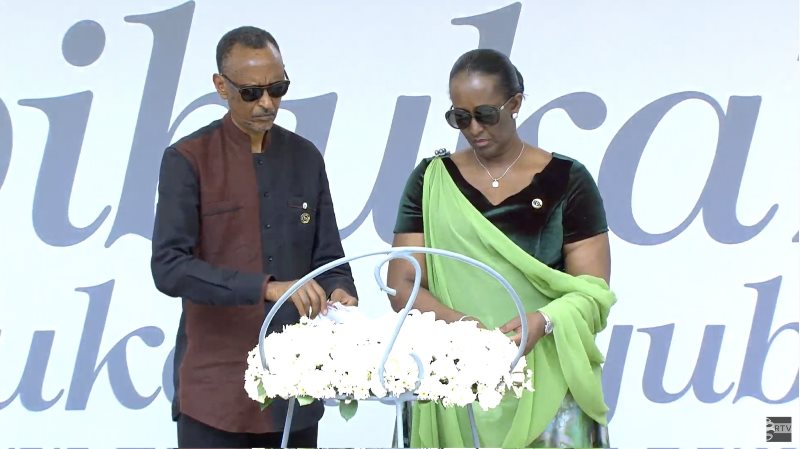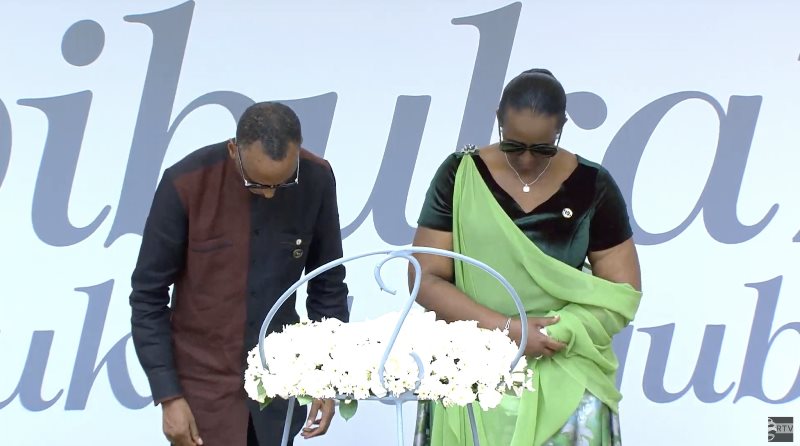
President Kagame and First Lady Jeannette Kagame paying tribute to Genocide victims at Kigali Genocide memorial
Flags in Rwanda were flown half-mast as Rwanda starts commemoration of the 1994 Genocide against Tutsi where over one million Tutsi were massacred between April and July.
They were killed by Hutu extremists, Interahamwe members-the youth wing of the then ruling party and some personnel from national defence and police forces.
The commemoration-Kwibuka 28 starts with a national mourning week from April 7-13 and proceeds until July 3 with commemoration activities.
Today, the head of State – President Paul Kagame together with the First Lady Jeannette Kagame light the flame of remembrance at Kigali Genocide memorial and lay wreath at the mass graves in tribute to more than 250,000 victims who lay to rest at this memorial.
More activities through the week and in 100 days will include; paying tribute to the Genocide victims at the memorials across the country.
Genocide survivors and the community at large lay wreath at mass graves and also burry in dignity the victims whose body were recently retrieved from places where killers dumped them.
During this period, Rwandans also attend sessions hosted by historians, academicians, researchers and politicians who bring a range of topics to the attention of the community.
Themes are around the origins of divisionism in Rwanda, the regimes that prepared, tried and executed the Genocide, justice in the aftermath of the tragedy, and the Genocide denial.
They also talk about Rwanda’s rebirth and hope of better future and how the government is building its diplomacy to spearhead the “Genocide never again” resolve.
As Rwanda commemorates, trials of Genocide suspects continue at international level and locally.
One of most awaited cases involves Félicien Kabuga against prosecution of United Nations Residual Mechanism which took over from the UN Criminal Tribunal for Rwanda based in Arusha-Tanzania.
Kabuga who is considered in Rwanda as the mastermind of the Genocide was arrested in France on May 15, 2020.
In 2012, Rwanda had tried nearly two million Genocide suspects within ten years courtesy of participatory justice – Gacaca. Scores of other suspects continue to be tried in mainstreaming courts.
Some cases were referred to Rwanda from UN tribunal and countries which extradited Genocide suspects.
The government led by Rwanda Patriotic Front (RPF) Inkotanyi which stopped the Genocide on July 3,1994 continued to encourage Genocide suspects to plead guilty, seek forgiveness from genocide survivors and potentially, get lenient punishments.

President Kagame and First Lady Jeannette Kagame
The move paid off. Scores of Genocide perpetrators saw their punishments reduced or converted into works of public interests(TIGE) for some years and so on.
This largely contributed to national unity and reconciliation. The process of apologizing allowed Genocide survivors to collect news around the death of their relatives.
However, retrieving the bodies of Genocide victims who were dumped in several areas is still work in progress.
Meanwhile, Rwanda continues to face genocide denial movements. Some are said to include descendants of Genocide architects.

